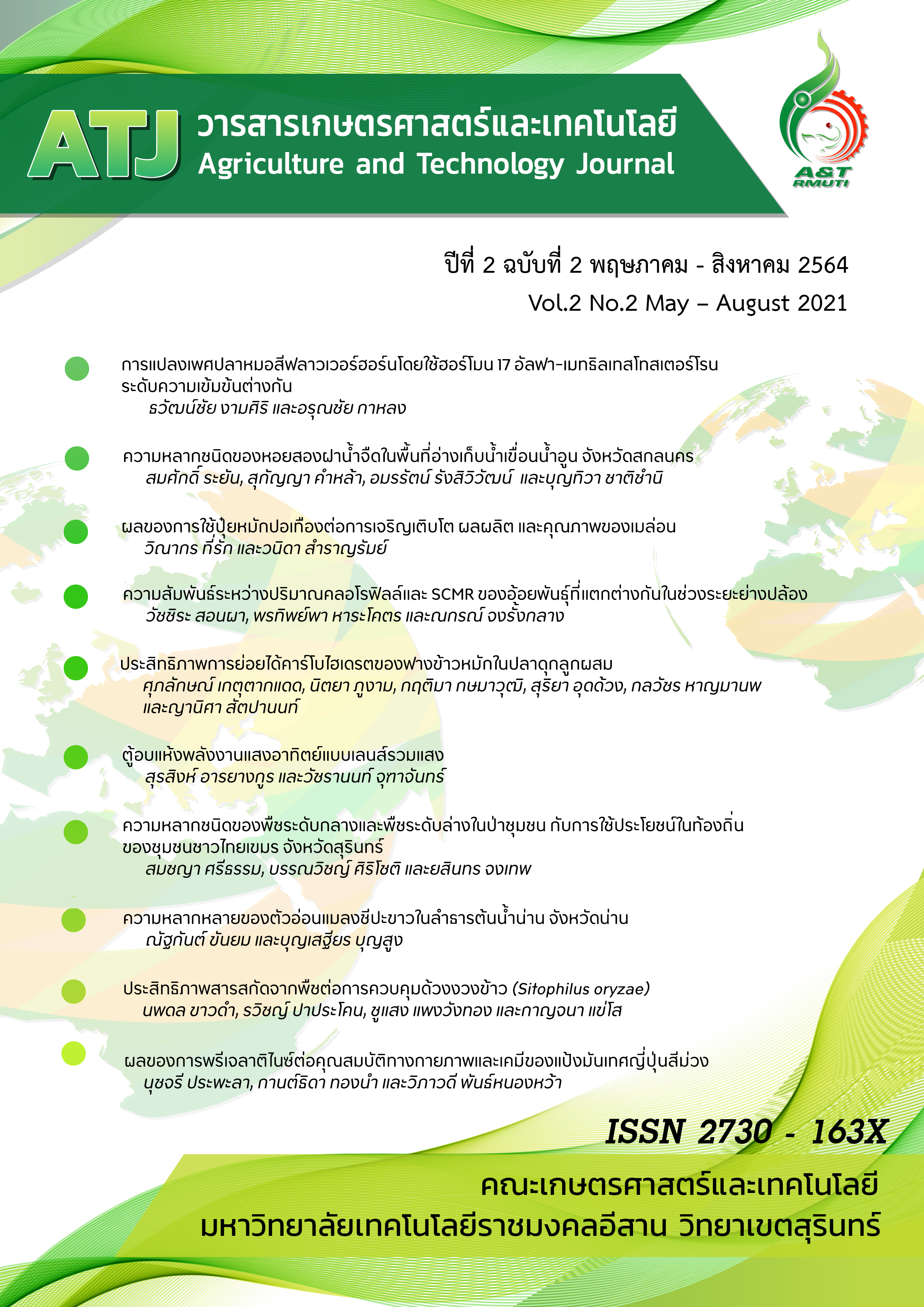ประสิทธิภาพการย่อยได้คาร์โบไฮเดรตของฟางข้าวหมักในปลาดุกลูกผสม
คำสำคัญ:
ฟางข้าว, การหมัก, การย่อยได้, ปลาดุกลูกผสมบทคัดย่อ
การศึกษาประสิทธิภาพการย่อยได้คาร์โบไฮเดรตของฟางข้าวหมักในปลาดุกลูกผสมในห้องปฏิบัติการ โดยวางแผนการทดลองแบบ 4x5 แฟคทอเรียลแบบสุ่มสมบูรณ์ โดยหมักฟางข้าวในสภาวะไร้อากาศร่วมกับการกำหนดปัจจัย 2 ปัจจัย ประกอบด้วยปัจจัยที่ 1 คือระยะเวลาการหมักที่ 0, 24, 48 และ62 ชั่วโมง ปัจจัยที่ 2 คือ สารช่วยหมัก โดยการเติมกากน้ำตาลที่ระดับ 0, 2, 4, 6 และ 8 % มีกลุ่มการทดลองทั้งหมด 20 กลุ่มการทดลอง กลุ่มการทดลองละ 6 ซ้ำ โดยนำตัวอย่างปลาดุกลูกผสมน้ำหนักเฉลี่ย 161.54±10.96 กรัมต่อตัว มาสกัดเอนไซม์จากลำไส้ พบกิจกรรมของเอนไซม์อะไมเลส 0.344±0.043 Unit/mg protein และกิจกรรมของเอนไซม์เซลลูเลส 0.020±0.003 Unit/mg proteinเมื่อทดสอบประสิทธิภาพการย่อยฟางข้าวหมักตามชุดการทดลอง พบว่า ระดับกากน้ำตาลและระยะเวลาในการหมักมีอิทธิพลอย่างมีนัยสำคัญต่อประสิทธิภาพการย่อยได้ของน้ำตาลมอลโตส (p≤0.05) และยังพบอิทธิพลร่วมระหว่างระดับกากน้ำตาล และระยะเวลาการหมักฟางข้าว (p≤0.05) ซึ่งเมื่อเติมกากน้ำตาลระดับต่างกัน 5 ระดับแต่ไม่มีการหมักฟางข้าวพบว่า ไม่มีผลต่อการย่อยได้คาร์โบไฮเดรตซึ่งปลาดุกลูกผสมสามารถย่อยคาร์โบไฮเดรตได้ 58.57-59.21 มิลลิกรัมมอลโตสต่อฟางข้าว 1 กรัม ระดับที่เหมาะสมในการหมักฟางข้าวเพื่อเพิ่มประสิทธิภาพการย่อยคาร์โบไฮเดรตของเอนไซม์ปลาดุกลูกผสม คือ การเติมกากน้ำตาลที่ระดับ 2% ร่วมกับการหมักเป็นระยะเวลา 24 ชั่วโมง โดยใช้จุลินทรีย์จากธรรมชาติ โดยมีค่าเท่ากับ 77.28±1.68 มิลลิกรัมมอลโตสต่อฟางข้าว 1 กรัม ซึ่งสามารถใช้เป็นแนวทางปฏิบัติเพื่อเพิ่มมูลค่าและการใช้ประโยชน์จากฟางข้าวในอาหารปลาดุกลูกผสมได้
References
กรมประมง. (2562). สถิติการประมงแห่งประเทศไทย พ.ศ. 2560. กองนโยบายและยุทธศาสตร์พัฒนาการประมง กรมประมง. กระทรวงเกษตรและสหกรณ์: กรุงเทพฯ
เจษฎา ธีรศรัณยานนท์, อรพินท์ จินตสถาพร และศรีน้อย ชุ่มคำ. (2557). การศึกษากิจกรรมเอนไซม์โปรติเอส อะไมเลสเซลลูเลส และไลเปสในระบบทางเดินอาหารของปลากะพงขาว (Lates calcarifer). ใน การประชุมทางวิชาการของ มหาวิทยาลัยเกษตรศาสตร์ 4-7 กุมภาพันธ์ 2557. มหาวิทยาลัยเกษตรศาสตร์. กรุงเทพฯ. 318-325.
ฉัตรชัย กิติพรชัย, อภิญญา ผลิโกมล, อุราภรณ์ สะอาดสุด, สกุณณี บวรสมบัติ, สมจิตร อยู่เป็นสุข, วสุ ปฐมอารีย์, นิเวศ ศรีล้อม, สมบัติ ใจดำ และวินัย เสียงหวาน. (2553). การผลิตปุ๋ยอินทรีย์น้ำจากเศษอาหารโรงอาหารภาควิชา ชีววิทยาและอาหารเลี้ยงเชื้อที่ใช้แล้วจากห้องปฏิบัติการสาขาวิชาจุลชีววิทยา ภาควิชาชีววิทยา. รายงานการวิจัย. ภาควิชาจุลชีววิทยาและชีววิทยา คณะวิทยาศาสตร์ มหาวิทยาลัยเชียงใหม่ เชียงใหม่.
ดนุวัต เพ็งอ้น, อนันต์ ปินตารักษ์, พัฒน์ กสิกรรมยืนยง และสุชัญญา อรุณรุ่งโรจน์. (2552). การผลิตเชื้อจุลินทรีย์สำหรับย่อย ลายสารในขยะและน้ำเสียเชิงพาณิชย์. รายงานการวิจัย. ภาควิชาพืชไร่ คณะผลิตกรรมการเกษตร มหาวิทยาลัย แม่โจ้ เชียงใหม่.
พันธ์ทิพย์ กล่อมเจ๊ก และปฐมพร น้อยจันทร์. (2561). การศึกษาคุณภาพของปุ๋ยหมักจากการหมักร่วมระหว่างฟางข้าวและน้ำเสียฟาร์มสุกร. วารสารวิทยาศาสตร์และเทคโนโลยี มหาวิทยาลัยมหาสารคาม. 37(5): 647-658.
รุ่งกานต์ กล้าหาญ, มนตรี ปัญญาทอง และขันชัย ดั้นเมฆ. (2559). การย่อยได้แบบ in vitro ของซังข้าวโพดด้วยเอนไซม์ จาก ทางเดินอาหารของปลานิลและเอนไซม์เซลลูเลสจากเชื้อรา Trichoderma viride. วารสารแก่นเกษตร 44 ฉบับพิเศษ (1): 630-635.
วิชิต เกตุพงษ์พันธุ์. (2554). ผลของการใช้ฟางข้าวหมักยูเรียกับอาหารที่เหลือจากการเลี้ยงหนอนแมลงวันผลไม้ในระดับ ต่างกันต่อสมรรถภาพของโคเนื้อ. วารสารวิจัย. 4(2): 65-74.
ศุภลักษณ์ เกตุตากแดด, นริศรา สุรทิพย์ และบัณฑิต ยวงสร้อย. (2563). กิจกรรมของเอนไซม์ย่อยอาหารในปลาสวาย(Pangasianodon hypophthalmus) ระยะโตเต็มวัย. วารสารแก่นเกษตร. 48(3): 405-416.
Bernfeld P. (1955). Amylases, α and ß. Method in Enzymology. Academic Press, NY.
Cao Y., Takahashi T., Horiguchi K.I. and Yoshida N. (2010). Effect of adding lactic acid bacteria and molasses on fermentation quality and in vitro ruminal digestion of total mixed ration silage prepared with whole crop rice. Grassland Science. 56(1): 19–25.
Chen L., Guo G., Yuan X., Shimojo M., Yu C. and Shao T. (2014). Effect of applying molasses and propionic acid on fermentation quality and aerobic stability of total mixed ration silage prepared with whole-plant corn in Tibet. Asian-Australasian Journal of Animal Sciences. 27(3): 349–356.
Das K.M. and Tripathi S.D. (1991). Studies on the digestive enzymes of grass carp, Ctenopharyngodon idella (Val.). Aquaculture. 92: 21–32.
De Silva S.S. and Anderson T.A. (1995). Fish Nutrition in Aquaculture. Chapman & Hall: UK.
Fagbenro O.A. (1990). Food composition and digestive enzymes in the gut of pond-cultured Clarias isheriensis (Sydenham 1980), (Siluriformes: Clariidae). Journal of Applied Ichthyology. 6(2): 91-98.
Gaxiola G., Cuzon G., García T., Taboada G., Brito R., Chima M.E.I., Paredes A., Soto L., Rosas C. and Wormhoudt A.V. (2005). Factorial effects of salinity, dietary carbohydrate and moult cycle on digestive carbohydrases and hexokinases in Litopenaeus vannamei (Boone, 1931). Comparative Biochemistry and Physiology. 140(1): 29-39.
Guillaume J., Kuashik S., Bergot P. and Metailler R. (2001). Nutrition and feeding of fish and crustaceans. Praxis publishing: UK.
Guo G., Yuan X., Li L., Wen A. and Shao T. (2014). Effects of fibrolytic enzymes, molasses and lactic acid bacteria on fermentation quality of mixed silage of corn and hulless-barely straw in the Tibetan Plateau. Grassland Science. 60(1): 240-246.
Halver J.E. and Hardy R.W. (2002). Fish Nutrition. Academic Press: USA.
Hidalgo M.C., Urea E. and Sanz A. (1999). Comparative study of digestive enzymes in fish with different nutritional habits. Proteolytic and amylase activities. Aquaculture. 170(3): 267-283.
Hlophe S.N. and Moyo N.A.G. (2013). The aquaculture potential of Tilapia rendalli in relation to its feeding habits and digestive capabilities. Physics and Chemistry of the Earth. 66(1): 33-37.
Iranzo M., Cañizares J.V., Roca-Perez L., Sainz-Pardo I., Mormeneo S. and Boluda R. (2004). Characteristics of rice straw and sewage sludge as composting materials in Valencia (Spain). Bioresource Technology. 95(1): 107-112.
Jian W., Lei C., Xian-jun Y., Gang G., Jun-feng L., Yun-feng B. and Tao S. (2017). Effects of molasses on the fermentation characteristics of mixed silage prepared with rice straw, local vegetable by-products and alfalfa in Southeast China. Journal of Integrative Agriculture. 16(3): 664-670.
Kattakdad S., Jintasataporn O., Worawattanamateekul W. and Chumkam S. (2018). pH characterization of digestive enzyme and In vitro digestibility of red bee shrimp Caridina cantonensis (Decapoda: Atyidae). Journal of Aquaculture Research & Development. 9(2): 1-6.
Krogdahl A., Hemre G.I. and Mommsen T.P. (2005). Carbohydrates in fish nutrition: digestion and absorption in postlarval stages. Aquaculture Nutrition. 11(2): 103-122.
Li J., Shen Y. and Cai Y. (2010). Improvement of fermentation quality of rice straw silage by application of a bacterial inoculant and glucose. Asian-Australasian Journal of Animal Sciences. 23(7): 901-906.
Li X., Zhang R. and Pang Y. (2008). Characteristics of dairy manure composting with rice straw. Bioresource Technology. 99(2): 359-367.
Lowry H.O., Rosebrough J.N., Farr A.L. and Randall R.J. (1951). Protein measurements with the Folin phenol reagent. Journal of Biological Chemistry. 193(1): 265-275.
Miller G.L. (1959). Use of dinitrosalicylic acid reagent for determination of reducing sugar. Analytical Chemistry. 31(3): 426-428.
Qian X., Shen G., Wang Z., Guo C., Liu Y., Lei Z. and Zhang Z. (2014). Co-composting of livestock manure with rice straw: Characterization and establishment of maturity evaluation system. Waste Management. 34(2): 530-535.
Weinberg Z.G., Chen Y. and Weinberg P. (2008). Ensiling olive cake with and without molasses for ruminant feeding. Bioresource Technology. 99(6): 1526–1529.
Wuisman Y., Hiraoka H., Yahaya M.S., Takeda M., Kim W., Takahashi T. and Goto M. (2006). Effects of phenylalanine fermentation byproduct and sugarcane molasses on fermentation quality and rumen degradation of whole crop barley (Hordeum vulgare L.) silage in situ. Grassland Science. 52(2): 73-79.
Xing L., Chen L.J. and Han L.J. (2009). The effect of an inoculant and enzymes on fermentation and nutritive value of sorghum straw silages. Bioresource Technology. 100(1): 488-491.
Yunus M., Ohba N., Shimojo M., Furuse M. and Masuda Y. (2000). Effects of adding urea and molasses on napiergrass silage quality. Asian-Australasian Journal of Animal Sciences. 13(11): 1542-1547.
Zhao J., Dong Z., Li J., Chen L., Bai Y., Jia Y. and Shao T. (2019). Effects of lactic acid bacteria and molasses on fermentation dynamics, structural and nonstructural carbohydrate composition and in vitro ruminal fermentation of rice straw silage. Asian-Australasian Journal of Animal Sciences. 32(6):
–791.
Downloads
เผยแพร่แล้ว
Versions
- 15-02-2024 (2)
- 30-08-2021 (1)
How to Cite
ฉบับ
บท
License
Copyright (c) 2021 วารสารเกษตรศาสตร์และเทคโนโลยี

This work is licensed under a Creative Commons Attribution-NonCommercial-NoDerivatives 4.0 International License.
เนื้อหาและข้อมูลในบทความที่ลงตีพิมพ์ในวารสารทดสอบระบบ ThaiJo2 ถือเป็นข้อคิดเห็นและความรับผิดชอบของผู้เขียนบทความโดยตรงซึ่งกองบรรณาธิการวารสาร ไม่จำเป็นต้องเห็นด้วย หรือร่วมรับผิดชอบใดๆ
บทความ ข้อมูล เนื่อหา รูปภาพ ฯลฯ ที่ได้รับการดีพิมพ์ในวารสารทดสอบระบบ ThaiJo2 ถือเป็นลิขสิทธิ์ของวารสารทดสอบระบบ ThaiJo2 หากบุคคลหรือหน่วยงานใดต้องการนำทั้งหมดหรือส่วนหนึ่งส่วนใดไปเผยแพร่หรือเพื่อกระทำการใดๆ จะต้องได้รับอนุญาตเป็นลายลักอักษรณ์จากวารสารทดสอบระบบ ThaiJo2 ก่อนเท่านั้น






